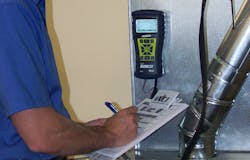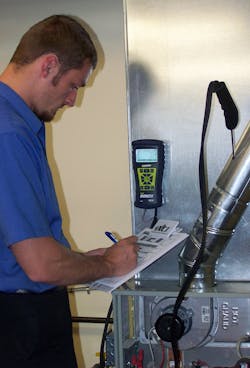Will Three Simple Tests Increase Your Maintenance Agreement Value?
Fall is upon us, and regardless of where you look, you probably see advertisements for low-price HVAC maintenance agreements. How many advertisements do you think address what a homeowner wants from a maintenance agreement? Compare the last promotion you saw or ran with these four reasons your customers typically sign up for them.
1. Assure safe equipment operation
2. Identify early breakdown causes, problems, and damage (water)
3. Verify their system performs at its best possible efficiency
4. Get a quick response in an emergency.
Time for a tough question: Do your maintenance calls address those four customer concerns? Now for an even tougher question. Are your technicians even looking for these homeowner concerns, or is their only motivation to find as many problems as possible to sell new equipment?
You create relationships with your customers during maintenance calls. Do the right things, and you establish trust. Do the wrong things, and you'll end up with more negative Google reviews than you can count. Let's look at three high-level tests you can add to your maintenance calls that address many homeowner concerns and set you apart from the competition.
Carbon Monoxide Testing
Safety tops the list as a maintenance priority for many customers. CO (carbon monoxide) is a colorless and odorless gas that presents a potential for unseen danger in many homes, especially those with fuel-fired equipment. If you've noticed CO alarms in your customer's homes, they're aware of this deadly gas.
Testing for ambient CO in a home should be a maintenance call requirement and the first place to start. Each technician should carry a low-level CO monitor to ensure the buildings they service are safe to work. If ambient CO levels exceed 35 ppm (parts per million), it is not safe to continue maintenance procedures.
You might wonder if all this is necessary if a homeowner has a store-bought CO alarm. Over-the-counter CO alarms only detect and sound an alarm at higher CO levels. Why not recommend low-level CO monitors to your customers to provide them with real 24/7 protection? Conditions that lead to increased CO production can change while you aren't there.
Static Pressure Testing
Total external static pressure (TESP) is another essential test to perform during maintenance. Why? Because it incorporates the duct system into the maintenance call and causes technicians to look beyond the equipment for system issues. It shows overall HVAC system health and uncovers problems that lead to early breakdowns.
TESP is the total of pressures taken where air enters the equipment (negative pressure -) and where air exits it (positive pressure +). The two pressures added together reveal the total pressure the fan must push and pull against. Think of this reading as an indicator of the HVAC system's overall health, similar to a person's blood pressure.
A total external static pressure test incorporates the duct system into the maintenance call and causes technicians to look beyond the equipment for system issues. It shows overall HVAC system health and uncovers problems that lead to early breakdowns.
To diagnose the measurement, compare your measured TESP to the maximum rated TESP found on the air handling equipment's nameplate. If measured TESP exceeds rated TESP, chances are high that there's an airflow problem causing system issues.
To uncover excessive TESP cause(s), you can add filter pressure drop, coil pressure drop, and duct pressure measurements to your testing repertoire. They help you identify restrictive components in less than five minutes. The highest pressure(s) is the highest area(s) of airflow resistance.
Supply Register and Return Grille Temperatures
Maintenance calls are the perfect time for verifying supply and return air temperatures at the air-handling equipment. Equipment temperature change, or Delta T (∆t), is an important measurement to verify proper equipment operation.
However, equipment temperatures aren't enough. You must look beyond the box to diagnose duct system performance issues that lead to increased run time and comfort complaints. You'll need supply register and return grille temperature measurements to find these problems. The best places to take these measurements are at the farthest register and grille from the equipment. Subtract them from each other to determine system ∆t.
Next, compare equipment ∆T to system ∆T to see how poorly insulated, and leaky ducts affect system performance. If the system is in a hot attic, it shouldn't surprise you if there's a big difference in these measurements. You may have just provided your customer with a missing piece of information. They don't need bigger equipment. Instead, they need better ducts.
Get Started
These three tests during routine maintenance capture valuable information you need to ensure safe operation, identify problems early and verify how the system performs. Once you become skilled at these measurements, you can add them to your maintenance calls with less than 10 minutes of testing.
The good news is these tests will replace 15 minutes of checklist items you were already doing that don't actually address performance. Testing should make your work easier, not add more steps to it. You're doing it wrong if you aren't eliminating non-essential fluff from your maintenance calls with testing.
It's important to give yourself time to learn these skills, understand their context, and use them to identify maintenance issues. If you run into challenges, don't give up after the first few attempts.
Start with CO testing this fall. Since your customers are turning their furnaces on for the first time, they're already thinking about CO safety. Next, add static pressure testing. It will help your technicians uncover the reasons they discovered all those cracked heat exchangers and pesky hi-limit trips. After you master static pressure, add system temperatures. You'll see why so many oversized furnaces appear to operate like they're correctly sized.
It's important to give yourself time to learn these skills, understand their context, and use them to identify maintenance issues. If you run into challenges, don't give up after the first few attempts. To build your confidence, test and diagnose your start-ups first. If you find issues with your systems, document them and look for ways that you might resolve the issues to improve performance.
Once you work out the kinks, implement these tests into your regular maintenance calls. When you measure, you'll find a lot of systems that need your help. Have a game plan for how you will handle this additional revenue stream.
If you're looking for lifelong customers to build your business, consider these three high-level tests you can add to your maintenance calls. They address many homeowner concerns and set the stage for great relationships for years to come.
David Richardson serves the HVAC industry as training director at the National Comfort Institute, Inc. (NCI). NCI specializes in training that focuses on improving, measuring, and verifying HVAC and Building Performance.
If you're an HVAC contractor or technician interested in learning more about CO testing, contact David at ncilink.com/ContactMe or call 800-633-7058. NCI's website www.nationalcomfortinstitute.com is full of free technical articles and downloads to help you improve your professionalism and strengthen your company.
About the Author
David Richardson
Director, technical curriculum
David Richardson serves the HVAC industry as director of technical curriculum at National Comfort Institute, Inc. (NCI), Avon, Ohio. NCI specializes in training that focuses on improving, measuring, and verifying HVAC and Building Performance.

